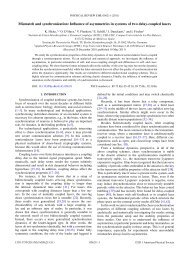DBI Analysis of Open String Bound States on Non-compact D-branes
DBI Analysis of Open String Bound States on Non-compact D-branes
DBI Analysis of Open String Bound States on Non-compact D-branes
Create successful ePaper yourself
Turn your PDF publications into a flip-book with our unique Google optimized e-Paper software.
CHAPTER 8. COMPUTATIONS 104see what comes out anyway. C<strong>on</strong>centrating <strong>on</strong> the ∼ ∂ 2 ω term, we see we can put thisterm in the right form by applying the substituti<strong>on</strong>The sec<strong>on</strong>d order term hereby becomesω −→ −z ( 1 − C 2) + 1. (8.41)4 ( ω − C 2) (ω − 1) ( ∂ 2 ωf ) −→ −4 (1 − z)z. (8.42)The <strong>on</strong>ly thing left to do is multiply through by −4 −1 . Going through the same moti<strong>on</strong>sfor the other terms, the fully transformed equati<strong>on</strong> becomes (courtesy <str<strong>on</strong>g>of</str<strong>on</strong>g> Mathematica):0 ={ [2 − ( −5C 2 + 5 + kE 2) z + ( C 2 − 1 ) ( 6C 2 − 3 − 2kE 2) z 2 − ( C 2 − 1 ) 2kE 2 z 3+ L 2 (z − 1) ( 1 + ( C 2 − 1 ) z ) ] [2× 4z ( 1 + ( C 2 − 1 ) z ) ] } −12f−{ [− 2 + 6C 2 + 2z − 6C 2 z + 4C 4 z − C 2 ( 1 + ( C 2 − 1 ) z ) 3/2+ ( 1 + ( C 2 − 1 ) z ) ] [5/2× 2 ( C 2 − 1 )( 1 + ( C 2 − 1 ) z ) ] } −1∂ z f+ z (1 − z)∂ 2 zf. (8.43)This is decidely not a hypergeometric equati<strong>on</strong>.
















